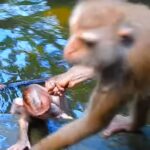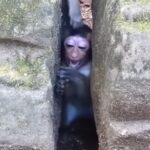In the heart of the wild, life is both beautiful and brutally unforgiving. Among the most touching, heart-wrenching scenes ever witnessed is that of a mother monkey mourning the loss of her baby. The image of a mother monkey holding her lifeless infant close, her face etched with sorrow, reminds us that grief is not solely a human experience. It is a deep, universal emotion, crossing species boundaries and connecting all living beings in their capacity to love, bond, and, ultimately, feel loss.
Monkeys, like many primates, form profound attachments to their offspring. From the moment of birth, a mother monkey’s world revolves around her baby. She nurses, protects, grooms, and carries her little one everywhere. Their bond is built not only on survival instincts but also on affection, trust, and constant physical closeness. It’s a relationship rooted in touch—tiny hands clinging to fur, mother’s arms cradling her young, grooming sessions filled with care and connection.
But when tragedy strikes—whether due to illness, accident, or predation—that close-knit bond is abruptly, painfully broken. Observers have often seen mother monkeys respond to such loss in a way that feels achingly familiar: they hold their baby’s lifeless body, sometimes for hours or even days, refusing to let go. The mother may rock gently, groom her baby as if willing life back into its small frame, or emit soft cries and whimpers that echo through the forest canopy.
One particularly poignant scene, witnessed by researchers and wildlife photographers alike, shows a mother monkey giving her deceased baby a final hug—a farewell that seems filled with unimaginable sadness. In that tender embrace, the depth of her grief is visible. She clings tightly, as if struggling to accept the reality that her precious baby is gone. The hug, though silent, speaks volumes: of love, loss, and the aching emptiness left behind.
This behavior challenges long-held beliefs that emotions like grief are solely human traits. Studies have increasingly shown that primates, elephants, dolphins, and many other animals exhibit clear signs of mourning. For the mother monkey, this final hug is not merely instinct—it reflects a genuine emotional response to a devastating loss.
Eventually, after hours or days, the mother will leave her baby’s body behind. But the moment of that farewell, her reluctant release, reveals the powerful grip of love and attachment. The other members of the troop may gather around, some even approaching to touch or inspect the deceased infant, offering a form of silent support. Life, as always in the wild, must continue, but the traces of that grief linger.

Witnessing such moments reminds us of the emotional lives of animals, their capacity for deep feeling, and the fragility of life itself. The mother monkey’s sad farewell hug is more than a heartbreaking image—it’s a profound testament to the universality of love and loss, a silent cry that resonates with anyone who has ever felt the ache of saying goodbye. In the wild, amid survival’s harsh realities, tenderness and sorrow coexist, teaching us the shared humanity present in all creatures.

